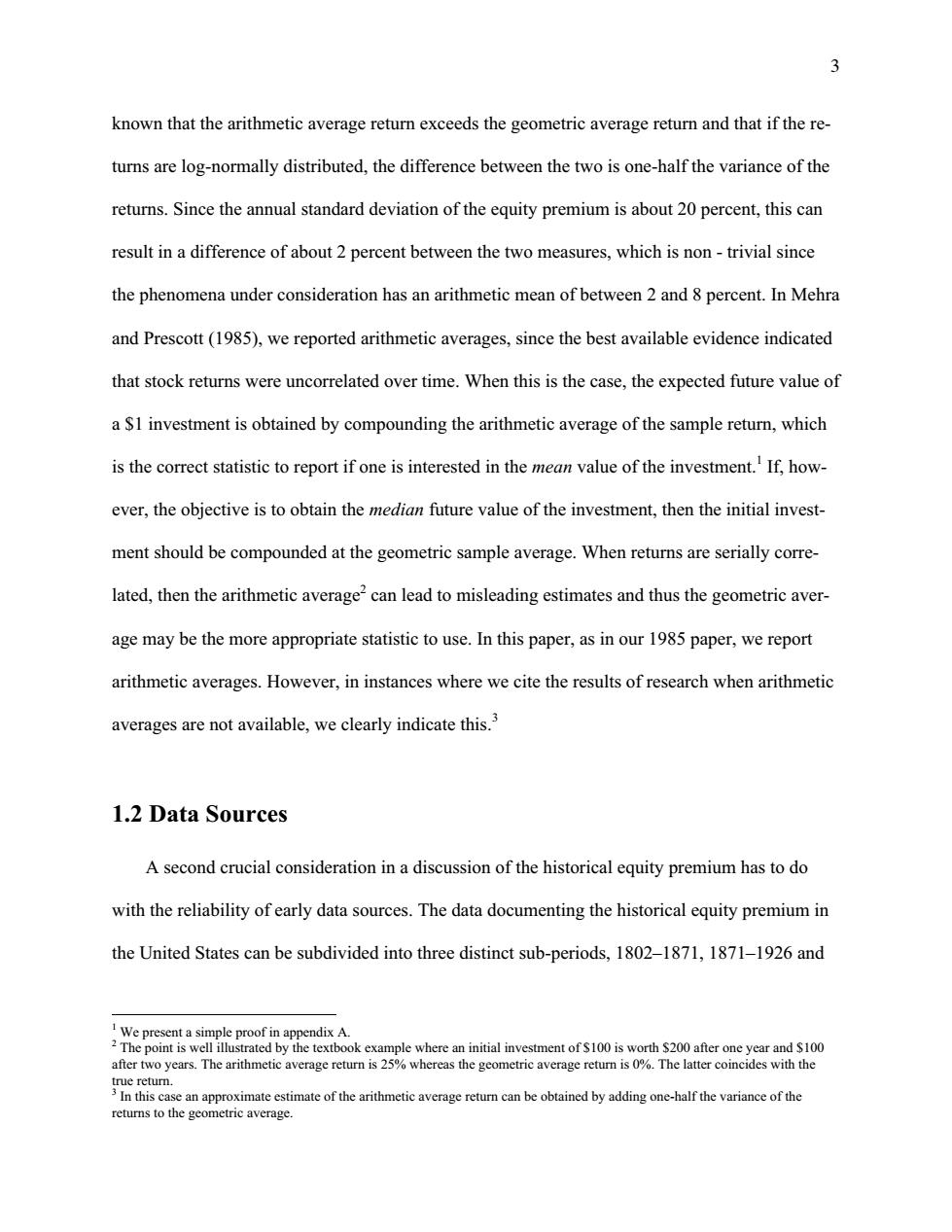正在加载图片...

3 known that the arithmetic average return exceeds the geometric average return and that if the re- turns are log-normally distributed,the difference between the two is one-half the variance of the returns.Since the annual standard deviation of the equity premium is about 20 percent,this can result in a difference of about 2 percent between the two measures,which is non-trivial since the phenomena under consideration has an arithmetic mean of between 2 and 8 percent.In Mehra and Prescott(1985),we reported arithmetic averages,since the best available evidence indicated that stock returns were uncorrelated over time.When this is the case,the expected future value of a S1 investment is obtained by compounding the arithmetic average of the sample return,which is the correct statistic to report if one is interested in the mean value of the investment.If,how- ever,the objective is to obtain the median future value of the investment,then the initial invest- ment should be compounded at the geometric sample average.When returns are serially corre- lated,then the arithmetic average2can lead to misleading estimates and thus the geometric aver- age may be the more appropriate statistic to use.In this paper,as in our 1985 paper,we report arithmetic averages.However,in instances where we cite the results of research when arithmetic averages are not available,we clearly indicate this.3 1.2 Data Sources A second crucial consideration in a discussion of the historical equity premium has to do with the reliability of early data sources.The data documenting the historical equity premium in the United States can be subdivided into three distinct sub-periods,1802-1871,1871-1926 and We present a simple proof in appendix A. 2The point is well illustrated by the textbook example where an initial investment of $100 is worth $200 after one year and $100 after two years.The arithmetic average return is 25%whereas the geometric average return is 0%.The latter coincides with the true return. 3In this case an approximate estimate of the arithmetic average return can be obtained by adding one-half the variance of the returns to the geometric average.3 known that the arithmetic average return exceeds the geometric average return and that if the returns are log-normally distributed, the difference between the two is one-half the variance of the returns. Since the annual standard deviation of the equity premium is about 20 percent, this can result in a difference of about 2 percent between the two measures, which is non - trivial since the phenomena under consideration has an arithmetic mean of between 2 and 8 percent. In Mehra and Prescott (1985), we reported arithmetic averages, since the best available evidence indicated that stock returns were uncorrelated over time. When this is the case, the expected future value of a $1 investment is obtained by compounding the arithmetic average of the sample return, which is the correct statistic to report if one is interested in the mean value of the investment.1 If, however, the objective is to obtain the median future value of the investment, then the initial investment should be compounded at the geometric sample average. When returns are serially correlated, then the arithmetic average2 can lead to misleading estimates and thus the geometric average may be the more appropriate statistic to use. In this paper, as in our 1985 paper, we report arithmetic averages. However, in instances where we cite the results of research when arithmetic averages are not available, we clearly indicate this.3 1.2 Data Sources A second crucial consideration in a discussion of the historical equity premium has to do with the reliability of early data sources. The data documenting the historical equity premium in the United States can be subdivided into three distinct sub-periods, 1802–1871, 1871–1926 and 1 We present a simple proof in appendix A. 2 The point is well illustrated by the textbook example where an initial investment of $100 is worth $200 after one year and $100 after two years. The arithmetic average return is 25% whereas the geometric average return is 0%. The latter coincides with the true return. 3 In this case an approximate estimate of the arithmetic average return can be obtained by adding one-half the variance of the returns to the geometric average